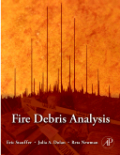
The study of fire debris analysis is vital to the function of all fire investigations, and, as such, Fire Debris Analysis is an essential resource for fireinvestigators. The present methods of analysis include the use of gas chromatography and gas chromatography-mass spectrometry, techniques which are well established and used by crime laboratories throughout the world. However, despite their universality, this is the first comprehensive resource that addresses their application to fire debris analysis.Fire Debris Analysis covers topics such as the physics and chemistry of fire and liquid fuels, the interpretation of data obtained from fire debris, and the future of the subject. Its cutting-edge material and experienced author team distinguishes this book as a qualityreference that should be on the shelves of all crime laboratories.Serves as acomprehensive guide to the science of fire debris analysisPresents both basicand advanced concepts in an easily readable, logical sequenceIncludes a full-color insert with figures that illustrate key concepts discussed in the tex. ‘Fire Debris Analysis bridges a gap between the fire investigator and the forensic analyst and provides a collection of chemical and physical properties and chromatograms of typical flammable and combustible liquids used as accelerantsand, to a lesser extent, animal/vegetable oils. It provides additional information and thus gives the reader a fuller picture of the analysis of fire debris samples. I have already noticed this 2008 published book in the reference libraries of private sector fire investigators.’ --Elizabeth C. Buc, Fire and Materials Research Laboratory, LLC, Eastpointe, MI, in Fire Technology, 44, 199-201, 2008. ‘The authors have produced what is by far the most comprehensive text on the subject of fire debris analysis ever written. Any criminalist who wants to learn how to conduct a proper fire debris analysis should read this book. Upon completion, the reader will know how the task is done. Experienced criminalists who already know fire debris analysis will appreciate the depth of understanding conveyed by this book, and all of the subtle nuances that it covers.The authors present the advantages and disadvantages of each choice that a fire debris analyst might make, and in almost all cases provide their own recommendation. The book is replete with small sidebars that go into the subtle details of new concepts as they are presented. The graphics are excellent, and acompanion website to the book presents additional resources.Compilations by multiple authors frequently suffer from the appearance of having been written by committee, but this volume is nearly seamless. The authors demonstrate not only a deep understanding of fire debris analysis, but also a genuine enjoymentof their work. Where else could one find an author extolling the aesthetic beauty of a chromatogram in which the retention time in minutes equals the carbon number?Fire Debris Analysis covers every important subject in the discipline, including the history of the various techniques, those techniques that have been found unsuitable for fire debris analysis, as well as those that may someday be of value in routine cases.This is truly a masterful work compiled by three masters of the discipline.’John Lentini, Scientific Fire Analysis, LLC
- ISBN: 978-0-12-663971-1
- Editorial: Academic Press
- Encuadernacion: Cartoné
- Páginas: 672
- Fecha Publicación: 28/01/2008
- Nº Volúmenes: 1
- Idioma: Inglés
